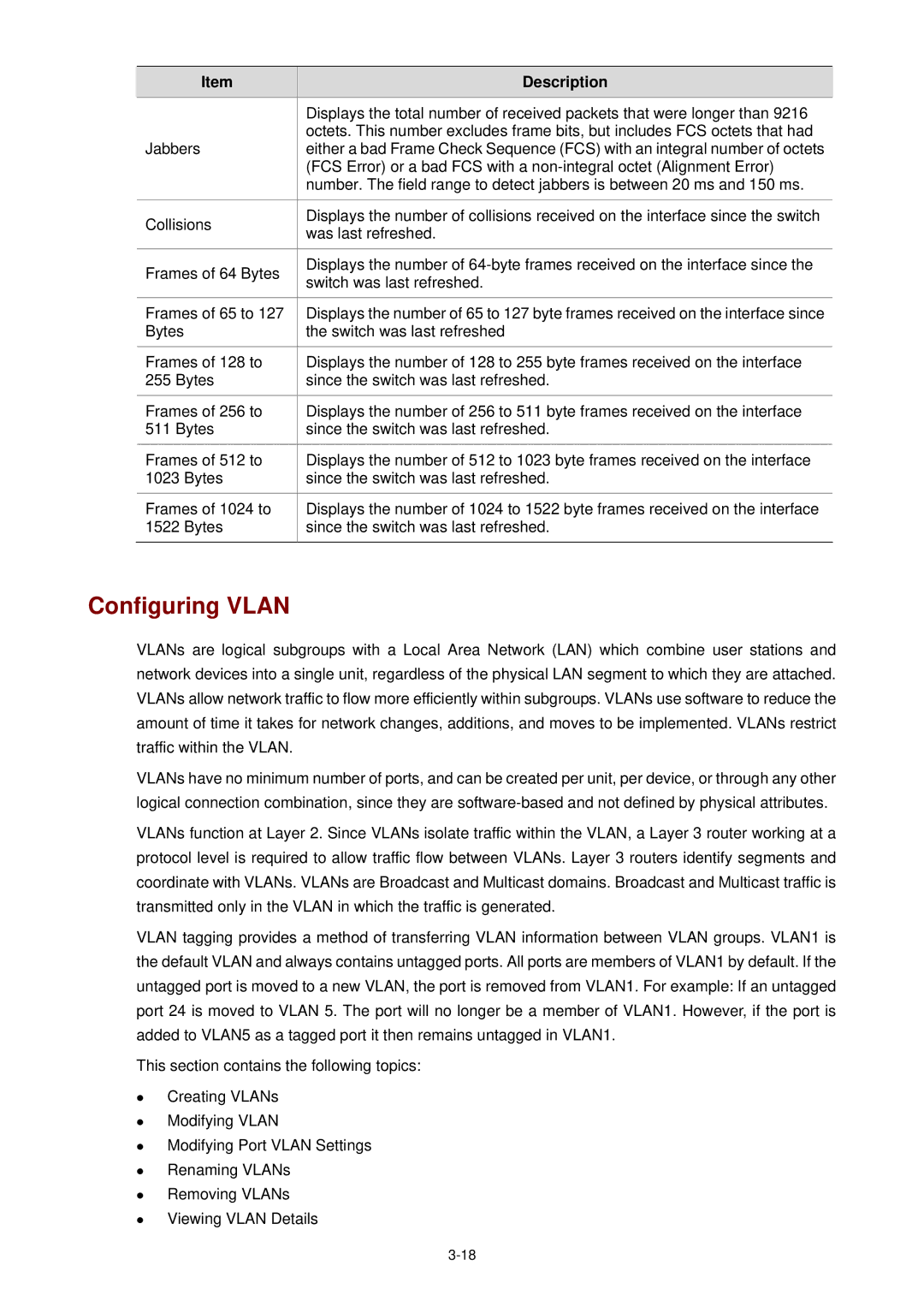| Item |
| Description |
|
|
| Displays the total number of received packets that were longer than 9216 |
| Jabbers |
| octets. This number excludes frame bits, but includes FCS octets that had |
|
| either a bad Frame Check Sequence (FCS) with an integral number of octets | |
|
|
| (FCS Error) or a bad FCS with a |
|
|
| number. The field range to detect jabbers is between 20 ms and 150 ms. |
|
|
|
|
| Collisions |
| Displays the number of collisions received on the interface since the switch |
|
| was last refreshed. | |
|
|
| |
|
|
|
|
| Frames of 64 Bytes |
| Displays the number of |
|
| switch was last refreshed. | |
|
|
| |
|
|
|
|
| Frames of 65 to 127 |
| Displays the number of 65 to 127 byte frames received on the interface since |
| Bytes |
| the switch was last refreshed |
|
|
|
|
| Frames of 128 to |
| Displays the number of 128 to 255 byte frames received on the interface |
| 255 Bytes |
| since the switch was last refreshed. |
|
|
|
|
| Frames of 256 to |
| Displays the number of 256 to 511 byte frames received on the interface |
| 511 Bytes |
| since the switch was last refreshed. |
|
|
|
|
| Frames of 512 to |
| Displays the number of 512 to 1023 byte frames received on the interface |
| 1023 Bytes |
| since the switch was last refreshed. |
|
|
|
|
| Frames of 1024 to |
| Displays the number of 1024 to 1522 byte frames received on the interface |
| 1522 Bytes |
| since the switch was last refreshed. |
|
|
|
|
Configuring VLAN
VLANs are logical subgroups with a Local Area Network (LAN) which combine user stations and network devices into a single unit, regardless of the physical LAN segment to which they are attached. VLANs allow network traffic to flow more efficiently within subgroups. VLANs use software to reduce the amount of time it takes for network changes, additions, and moves to be implemented. VLANs restrict traffic within the VLAN.
VLANs have no minimum number of ports, and can be created per unit, per device, or through any other logical connection combination, since they are
VLANs function at Layer 2. Since VLANs isolate traffic within the VLAN, a Layer 3 router working at a protocol level is required to allow traffic flow between VLANs. Layer 3 routers identify segments and coordinate with VLANs. VLANs are Broadcast and Multicast domains. Broadcast and Multicast traffic is transmitted only in the VLAN in which the traffic is generated.
VLAN tagging provides a method of transferring VLAN information between VLAN groups. VLAN1 is the default VLAN and always contains untagged ports. All ports are members of VLAN1 by default. If the untagged port is moved to a new VLAN, the port is removed from VLAN1. For example: If an untagged port 24 is moved to VLAN 5. The port will no longer be a member of VLAN1. However, if the port is added to VLAN5 as a tagged port it then remains untagged in VLAN1.
This section contains the following topics:
z
z
z
z
z
z
Creating VLANs
Modifying VLAN
Modifying Port VLAN Settings
Renaming VLANs
Removing VLANs
Viewing VLAN Details
